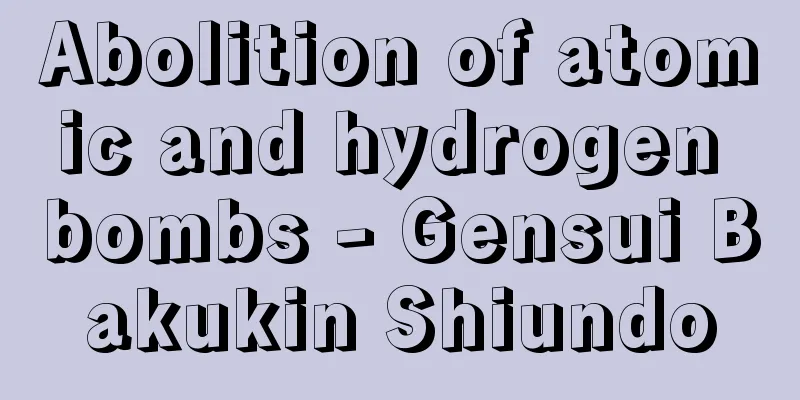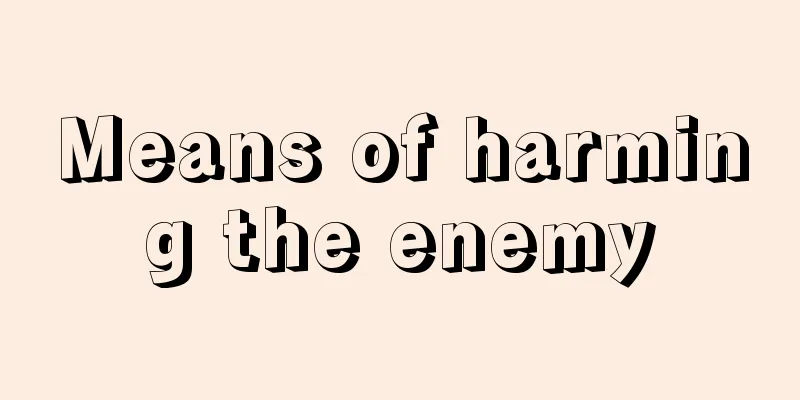Abolition of atomic and hydrogen bombs - Gensui Bakukin Shiundo

|
A movement calling for the prohibition and abolition of the manufacture, testing, and use of atomic and hydrogen bombs. The first large-scale World Peace Conference after World War II (ended in August 1945) was held simultaneously in Paris and Prague in April 1949 with the same agenda. The background to this was a sense of crisis that the abolition of atomic weapons was not being realized due to the United States' strong monopoly on atomic bombs, and also a sense of crisis over the Cold War between the United States and the Soviet Union that had become apparent since 1947. The Standing Committee established by the World Peace Conference (renamed the World Peace Council in November 1950) resolved at its third committee meeting in Stockholm, Sweden in March 1950 to launch a signature campaign calling for the unconditional prohibition of atomic weapons, the establishment of international control to guarantee this, and the treatment of the first government to use atomic weapons as a war criminal. This became the famous Stockholm Appeal. With the Korean War beginning in June of that year as a backdrop, this signature campaign quickly gained worldwide support, and by August of that year it had collected 300 million signatures, and by 1953 it had collected 500 million signatures (more than 6.45 million in Japan), preventing the United States from using an atomic bomb in the Korean War and becoming the source of the later anti-nuclear movement in Japan. [Naomi Shono] The impact of the Lucky Dragon No.5 incidentAlthough the Soviet Union's possession of atomic bombs, announced in September 1949, could have been interpreted as a defensive measure against the United States, in reality, this marked the start of a nuclear arms race centered on the United States and the Soviet Union. In October 1952, the United Kingdom also successfully tested an atomic bomb, and in November of the same year, the United States successfully conducted a preliminary test of a hydrogen bomb. Then, in August 1953, the Soviet Union also successfully tested a hydrogen bomb, and on March 1, 1954, the United States successfully tested a powerful hydrogen bomb, the 3F bomb, at Bikini Atoll. At that time, the Japanese tuna fishing boat Daigo Fukuryu Maru, which was operating near Bikini Atoll, was covered in radioactive ash from the test and returned to Yaizu in Shizuoka Prefecture. However, 23 crew members suffered from radiation damage (radio chief Aikichi Kuboyama died on September 23, 1954), and strong radiation was detected in the tuna it had loaded. This incident was a great shock to the Japanese people, and the sense of crisis that "we can't even eat tuna because of radioactive contamination" led to the fear of nuclear weapons becoming widespread among the Japanese people. The voices of the atomic bomb survivors of Hiroshima and Nagasaki, who had been isolated until then, finally began to be heard by the public. The resolutions to ban atomic weapons passed by local government assemblies and the House of Representatives and the House of Councillors immediately after the Lucky Dragon No. 5 incident, as well as the activities of private organizations, and especially the active signature campaigns by women in Hiroshima and Suginami Ward, Tokyo, served as catalysts for the anti-nuclear movement in Japan to become a nationwide movement involving all political parties. This movement also linked up with the aforementioned World Peace Council, and eventually led to the historic holding of the First World Conference Against Atomic and Hydrogen Bombs in Hiroshima on August 6, 1955 (Showa 30). More than 50 foreign representatives from 11 countries took part in the three-day conference bearing 660 million signatures, and 5,000 people from Japan took part representing more than 32 million signatories. This was the starting point for a world conference to be held every August thereafter, and the center of the global anti-nuclear movement shifted to Japan. The Japan Council Against Atomic and Hydrogen Bombs (Gensuikyo) was launched in September after the first world conference, and it established a policy to advance the anti-nuclear movement and the atomic bomb victim relief movement as two wheels of the same cart, and local anti-nuclear organizations were formed all over the country, including in Hiroshima and Nagasaki. [Naomi Shono] Political party intervention and division of the movementThe First World Conference was of an educational nature, but from the Second World Conference onwards, concrete measures were pursued year by year. In August 1956, at the Second World Conference in Nagasaki, the Japan Confederation of A- and H-Bomb Victims Organizations (Nihon Hidankyo) was formed, which marked a major advance in the movement of atomic bomb survivors, and in March of the following year, the National Atomic Bomb Victims Medical Care Act was promulgated. From the Third World Conference in Tokyo in August 1957, it was decided to hold an international preparatory conference. In 1959, when the Fifth World Conference was scheduled to be held in Hiroshima, public opinion in Japan was boiling over the issue of revising the Japan-US Security Treaty. At the beginning of the same year, the Japan Council Against Atomic and Hydrogen Bombs decided to make the issue of the Security Treaty an agenda item for the World Conference, as the contents of the Security Treaty revisions could be contrary to the goal of banning atomic and hydrogen bombs. However, the Liberal Democratic Party and its sympathizers did not accept this policy and withdrew from the movement. Meanwhile, the mass movement against the revision of the Security Treaty grew more intense, but in May 1960, the new Security Treaty was approved by a unilateral vote by the LDP. Reflecting the public's indignation at this, the Japan Council Against Atomic and Hydrogen Bombs decided to designate its 6th World Conference in Tokyo in August of that year as a "conference to fight the enemies of peace." The Democratic Socialist Party and its sympathizers, unable to agree with this policy, decided to withdraw from the movement, and in November of the following year, in cooperation with some LDP allies, launched the National Conference for the Prohibition of Nuclear Weapons and Peace Building (Kakukinkai). The fierce content of the "Tokyo Appeal" at the 6th World Conference in 1960, which used phrases such as "Let's advance our joint struggle against imperialism, the enemy of peace," drew criticism from women's and youth groups, and calls arose for the democratization of the leadership of the Japan Council Against Atomic and Hydrogen Bombs. However, the line taken at the 7th World Conference in August 1961 was unchanged from the previous year, and four organizations, the Socialist Party, Sohyo, Nisshokyo (Japan Council of Young People's Organizations), and Chifuren (National Liaison Council of Regional Women's Organizations), expressed no confidence in the executive board of the Japan Council Against Atomic and Hydrogen Bombs after the conference ended. Just at the end of August after the conference, the Soviet Union, which had unilaterally suspended nuclear testing for over three years, announced a resumption of testing, and in October tested a super-large 50-megaton hydrogen bomb. This triggered a conflict within the Japan Council Against Atomic and Hydrogen Bombs between the Socialist Party faction, which argued that "opposition to nuclear testing by any country should be made a principle of the movement," and the Communist Party faction, which argued that "nuclear tests by socialist countries are defensive and cannot be considered on the same level as others." On August 5, 1962, in the middle of the 8th World Conference in Tokyo, the Soviet Union conducted a nuclear test. After a heated debate, protests against this were not made. Since then, the conflict between the two parties in the Japan Council Against Atomic and Hydrogen Bombs became abnormal, but in July 1963, the United States, the United Kingdom, and the Soviet Union provisionally signed the Partial Nuclear Test Ban Treaty, and differences in opinion on this added fuel to the fire, leading to the withdrawal of the Socialist Party and Sohyo faction at the 9th World Conference in Hiroshima in August. Later, sympathizers joined in, and in February 1965 the Japanese National Congress Against Atomic and Hydrogen Bombs (Gensuikin Kokumin Kaigi) was launched. Since then, the three organizations, Gensuikin, Kokumin Kaigi, and Gensuikin Kokumin Kaigi, have been operating independently, and an independent citizens' movement that does not favor party affiliations has also begun to sprout. It can be said that the root cause of the movement's split was the intervention of political parties. Nevertheless, the significance of this movement continuing amidst hardships and not disappearing even after the split is clear when we consider what it would have been like had the movement not existed. [Naomi Shono] New unity and solidarityEventually, the NGO International Symposium on the Atomic Bomb Victims' Issues held in Japan in the summer of 1977 (Showa 52) was a catalyst for the creation of a new movement. The symposium, which discussed the issues of Hiroshima, Nagasaki, and Bikini anew, was proposed by the NGO (Non-Governmental Organization) Special Committee on Disarmament, and the Japanese Preparatory Committee brought together a wide range of groups and individuals, regardless of past history, party affiliation, or creed. Since that year, although the unified organization of the past has not been restored, solidarity and unified actions have been revived in the anti-nuclear movement, and we were able to send a unified delegation to the First United Nations Special Session on Disarmament (SSD) in 1978, and have held a unified world conference every August. Also, since 1981, a new anti-nuclear movement has flourished in Europe due to a sense of crisis over limited nuclear war, and solidarity with the Japanese movement has begun. Such unified world conferences in Japan continued until 1985, the 40th anniversary of the atomic bombings of Hiroshima and Nagasaki. However, conflict between the Japan Council Against Atomic and Hydrogen Bombs and the National Congress Against Atomic and Hydrogen Bombs over how the conference should be run flared up again in 1986, making it impossible to hold a Unified World Conference after 1987. Since then, joint efforts have been explored and implemented by civic groups, including the Youth Corps and the Local Women's Federation, on issues on which a wide range of citizens can agree, such as signature campaigns calling for the enactment of an A-bomb Victims Relief Law and the holding of an international symposium to mark the 50th anniversary of the bombing. The various past experiences of the anti-nuclear movement, which had its origins in Hiroshima, Nagasaki, and Bikini, teach future movements the importance of the following: people and organizations that do not respect human feelings are not persuasive; broad-minded acceptance of diverse movements that share the same goals; recognition of the importance of peace education for disarmament and democratization; and deep recognition that nuclear weapons are an absolute evil. Furthermore, if we clarify the specific common goal of the A-bomb Movement, it is to realize a nuclear weapons ban treaty in the United Nations. The United Nations was established in October 1945, when the Second World War ended, and adopted the Biological and Toxic Weapons Convention in 1972 and the Chemical Weapons Convention in 1993, including those for the Prohibition of Toxic Gases. It is significant that the United Nations has survived to the present day. As of October 2010, 192 countries are members of the United Nations, and it is thought that it could be the basis of a world federation. If the United Nations cannot realize a nuclear weapons ban treaty, global environmental destruction will also progress significantly. In other words, the abolition of nuclear weapons is a fundamental issue that calls into question the possibility of human coexistence. In order to solve this problem, the US government, the first country in the world to possess nuclear weapons, must decide to abolish nuclear weapons, and the Japanese government, the only country in the world to have suffered atomic bombings, must urge the US government to abolish nuclear weapons, based on its position of having consistently cooperated with the US government since the Second World War. [Naomi Shono] "The Movement to Ban Atomic and Hydrogen Bombs," by Imahori Seiji (1974, Ushio Publishing)" ▽ "30 Years of the Anti-Gensic and Hydrogen Bomb Movement," by Kumakura Hiroyasu (1978, Labor Education Center)" ▽ "Peace Education Practice Dictionary," edited by Hiroshima Peace Education Research Institute (1981, Labor Junposha)" ▽ "Is There a Future for Humanity?" by Shono Naomi (1982, Keiso Shobo)" ▽ "The Wave for the Abolition of Nuclear Weapons - Documenting the Anti-Gensic and Hydrogen Bomb Movement," by Iwata Hiroshi (1982, Rengo Publishing)" ▽ "Comprehensive Japanese Atomic Bomb Theory, 7 volumes, edited by Sakamoto Yoshikazu and Shono Naomi, with commentary by Iwata Hiroshi and Nakajima Tatsumi (1999, Japan Library Center)" ▽ "Is Hiroshima a Fairy Tale?" by Shono Naomi (Shincho Bunko) [References] | | | | | | | | |Source: Shogakukan Encyclopedia Nipponica About Encyclopedia Nipponica Information | Legend |
|
原爆および水爆の製造、実験、使用の禁止と廃棄を訴える運動。第二次世界大戦(1945年8月終結)後、初めての大規模な世界平和大会が、1949年4月パリとプラハで同時に同じ議題で開かれた。その背景には、アメリカの強硬な原爆独占政策のため原子兵器の廃棄が実現しないことへの危機感があり、また1947年から顕在化した米ソ冷戦への危機感があった。その世界大会によって設置された常任委員会(1950年11月世界平和評議会と改称)は、1950年3月、スウェーデンのストックホルムでの第3回委員会において、原子兵器を無条件に禁止すること、それを保障する国際管理を確立すること、最初に原子兵器を使用する政府を戦争犯罪人として取り扱うことなどを訴える署名運動の展開を決議した。これが有名なストックホルム・アピールである。この署名運動は、同年6月に始まった朝鮮戦争を背景に、たちまち世界的な支持を得て、同年8月まででも3億、1953年までには5億(日本では645万余)の署名を集め、朝鮮戦争でのアメリカによる原爆使用を防止するとともに、後の日本の原水禁運動の源流となった。 [庄野直美] 第五福竜丸事件の衝撃1949年9月に公表されたソ連の原爆保有は、アメリカに対する防衛的性格のものと理解されうる理由をもっていたとはいえ、現実は、ここにおいて米ソを中心とする核軍拡競争の火ぶたが切られたといえる。1952年10月イギリスも原爆実験に成功、同年11月アメリカは水爆予備実験に成功、ついで1953年8月ソ連も水爆実験に成功、さらに1954年3月1日アメリカはビキニ環礁において強力な水爆3F爆弾の実験に成功した。このときビキニ環礁の近海で操業中の日本のマグロ漁船第五福竜丸が実験による放射能の灰をかぶり、静岡県の焼津(やいづ)へ帰港したが、乗組員23人に放射線障害が現れ(1954年9月23日、久保山愛吉無線長死亡)、積んできたマグロからは強い放射能が検出された。この事件は大きなショックを国民に与え、「放射能汚染でマグロも食えない」という危機感から、核兵器の恐怖が広く国民に浸透することとなり、また、それまで閉じ込められていた広島、長崎の被爆者の声も、ようやく国民に届くようになっていく。第五福竜丸事件直後から始まった各地方自治体議会や衆参両院の原子兵器禁止決議、民間団体の運動、なかでも広島と東京都杉並区の婦人たちによる積極的な署名運動の展開などが契機となって、日本の原水禁運動はすべての政党も含む全国民的なものとなっていった。この運動は、前述の世界平和評議会とも連係をとり、やがて1955年(昭和30)8月6日歴史的な第1回原水爆禁止世界大会を広島で開催するに至った。3日間の大会には、11か国50人余の外国代表が6億6000万人の署名を担って参加、また国内からは3200万人余の署名者を代表して5000人が参加したが、これを出発点に以後毎年8月の世界大会が継続されるようになり、世界の原水禁運動の中心は日本に移った。第1回世界大会後の9月には原水爆禁止日本協議会(日本原水協)が発足し、原水禁運動と被爆者救援運動を両輪として進める方針を定めるとともに、広島、長崎をはじめ全国に地域原水禁組織がつくられていった。 [庄野直美] 政党の介入と運動の分裂第1回世界大会は啓蒙(けいもう)的性格のものであったが、第2回以後は年とともに具体的方策を追求していった。1956年(昭和31)8月、長崎の第2回世界大会において日本原水爆被害者団体協議会(日本被団協)が結成され、被爆者の運動も大きく前進することになり、翌1957年3月には国による被爆者医療法が公布された。1957年8月東京の第3回世界大会から国際予備会議が設けられることになった。第5回世界大会の広島開催が予定された1959年には、日米安全保障条約改定問題で国内の世論が沸騰していた。同年初頭、日本原水協は、安保改定の内容が原水爆禁止の目標に反する可能性があるとして、安保問題を世界大会の議題とする方針を決めた。しかし自民党とその同調者はこの方針を認めず、運動から離脱した。一方、安保改定に反対する大衆運動は激しさを増していったが、1960年5月自民党の単独強行採決によって新安保条約は承認された。これに対する民衆の憤激を反映して、日本原水協は東京での同年8月の第6回世界大会を「平和の敵と闘う大会」とする方針を決めた。この方針に賛同できない民社党とその同調者は、運動からの離脱を決定し、翌1961年11月には、自民党系の一部とも連携して核兵器禁止平和建設国民会議(核禁会議)を発足させることになる。「平和の敵・帝国主義との共同闘争を進めよう」などのことばを使用した1960年の第6回世界大会「東京アピール」の激しい内容は婦人団体や青年団体の批判も招く結果となり、日本原水協指導部の民主化を要望する声が出てきた。しかし、1961年8月の第7回世界大会の路線も前年と変わらなかったため、大会終了後、社会党、総評、日青協(日本青年団協議会)、地婦連(全国地域婦人団体連絡協議会)の4団体は日本原水協執行部の不信任を表明した。ときあたかも大会後の8月末、一方的核実験停止を3年余り実行していたソ連が実験再開を公表し、10月には50メガトンという超大型水爆の実験を行った。これを契機に日本原水協では、「いかなる国の核実験にも反対することを運動の原則とせよ」と主張する社会党系と、「社会主義国の核実験は防衛的なもので、他と同列視できない」と主張する共産党系の対立が表面化した。1962年8月5日、東京での第8回世界大会のさなかソ連が核実験を行った。激論のすえ、これに対する抗議は見送られた。以来、日本原水協における両党系の対立は異常なものとなったが、さらに1963年7月、米英ソ3国の部分的核実験停止条約仮調印が行われ、これへの評価の違いが火に油を注ぐこととなり、ついに8月の広島における第9回世界大会で社会党・総評系は離脱していった。その後、それへの同調者も加わり、1965年2月には原水爆禁止日本国民会議(原水禁国民会議)が発足した。以来、日本原水協、核禁会議、原水禁国民会議の3団体による運動が分立して進められ、政党系列を好まない独自の市民運動も芽生えていった。運動分裂の根本は、政党による介入にあったといえる。それにしても、この運動が苦難のなかで継続し、分裂後も消滅しなかったことの意義は、運動がなかったとしたときのことを考えれば明らかであろう。 [庄野直美] 新たな団結と連帯やがて、1977年(昭和52)の夏に日本で開かれた「NGO被爆問題国際シンポジウム」を契機に、新たな運動の団結が生まれた。ヒロシマ、ナガサキ、ビキニの問題を改めて討議したそのシンポジウムは、NGO(非政府組織)軍縮特別委員会の提唱によるもので、日本準備委員会には、過去のいきさつや党派、信条の違いを超えて広範な団体や個人が結集した。この年以来、かつてのような統一組織が再生したのではないとしても、原水禁運動に連帯と統一行動がよみがえり、1978年の第1回国連軍縮特別総会(SSD)にも統一代表団を送ることができ、毎年8月に統一世界大会を開催してきた。また1981年以来、限定核戦争への危機感から、ヨーロッパでも新たな反核運動が興隆し、日本の運動との連帯が始まった。このような日本での統一世界大会は、ヒロシマ、ナガサキの被爆40周年にあたる1985年まで続いた。しかし大会運営のあり方をめぐって、日本原水協と原水禁国民会議の対立が1986年から再燃し、1987年以降の統一世界大会開催はできなくなった。以後は、原爆被爆者援護法制定を求める署名運動や被爆50周年国際シンポジウムの開催など、広範な市民が一致できる課題において、青年団や地婦連などを含む市民団体共同の取り組みが模索、実行されている。 ヒロシマ、ナガサキ、ビキニを原点とする原水禁運動の過去のさまざまな経験は、今後の運動に次のことの重要性を教えている――人間らしい心をたいせつにしない人間や組織には説得力がないこと、目的を同じくする多様な運動をおおらかに認めあうこと、軍縮と民主化のための平和教育の重要性を認識すること、核兵器は絶対悪であることを深く認識すること。 さらに原水禁運動の具体的共同目標を明記すれば、それは核兵器禁止条約を国連において実現させることである。国連は、第二次世界大戦が終結した1945年10月に発足し、1972年に生物毒素兵器禁止条約の採択、1993年に毒ガスを含む化学兵器禁止条約の採択を実現し、また現在まで国連が存続できたことに重要な意味をもっている。国連には2010年10月時点で192か国が加盟しており、世界連邦の基礎になりうるとも考えられている。この国連において核兵器禁止条約を実現できないならば、世界的環境破壊も大きく進行するであろう。すなわち核兵器廃絶は、人類共生の可能性を問う基本的問題である。これを解決するためには、世界最初の核兵器保有国であるアメリカ政府が、核兵器廃絶を決断すること、また世界で唯一の被爆国である日本の政府は、第二次世界大戦後一貫してアメリカ政府へ協力してきた立場から、核兵器廃絶をアメリカ政府に働きかけることが必要であろう。 [庄野直美] 『今堀誠二著『原水爆禁止運動』(1974・潮出版社)』▽『熊倉啓安著『原水禁運動30年』(1978・労働教育センター)』▽『広島平和教育研究所編『平和教育実践事典』(1981・労働旬報社)』▽『庄野直美著『人間に未来はあるのか』(1982・勁草書房)』▽『岩垂弘著『核兵器廃絶のうねり――ドキュメント原水禁運動』(1982・連合出版)』▽『坂本義和・庄野直美監修、岩垂弘・中島竜美解説『日本原爆論大系』全7巻(1999・日本図書センター)』▽『庄野直美著『ヒロシマは昔話か』(新潮文庫)』 [参照項目] | | | | | | | | |出典 小学館 日本大百科全書(ニッポニカ)日本大百科全書(ニッポニカ)について 情報 | 凡例 |
Recommend
Childcare leave system - Ikujikyuushokuseido
… [Characteristics and gender discrimination] The...
Badari Culture - Badari Culture
Established in the second half of the 5th millenni...
Flower seal - Kaoin
… [Samurai and commoners' signatures] Next, a...
Cobaltite - cobaltite
The most important ore mineral of cobalt. It occu...
Abu Said bin Abiy al-Khayl - Abu Said bin Abiy al-Khayl
...The rhyme used was mainly a variation of the h...
Eleusine coracana (English spelling)
…[Tetsuo Koyama]. … From [Finger millet] ...annua...
Tamási Á. (English notation) TamasiA
...Radnóti Miklós (1904-1945), who died in a Nazi...
Inada stone
A biotite granite stone found in the Inada region...
Amekutsu Ookume - Amekutsu Ookume
⇒ Amatsukume no Mikoto Source: Kodansha Digital Ja...
Gold coin
Coins made of gold. The oldest coins are said to ...
Acalypha wilkesiana (English spelling) Acalypha wilkesiana
… [Takabayashi Masatoshi]. … *Some of the termino...
Coendous
...A arboreal porcupine with a long tail that can...
Orphan of the Storm - Stormbringer
...The plan to remake "Fading Flowers" ...
Subtropical Gyre
Anticyclonic circulations exist in the subtropical...
Plant growth regulator
A chemical that artificially alters the normal gro...









